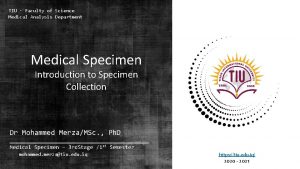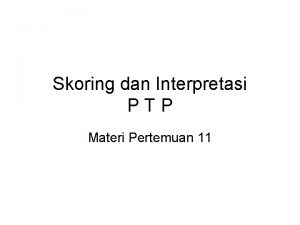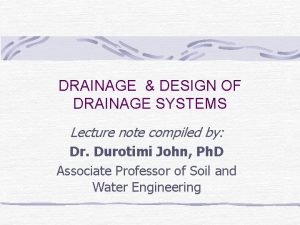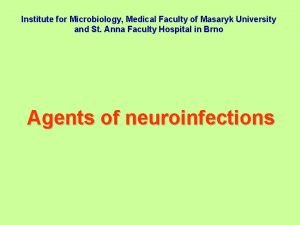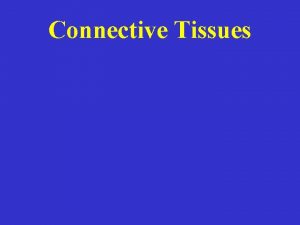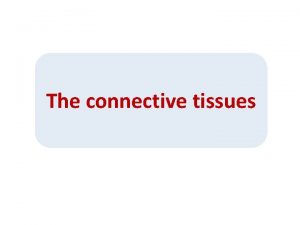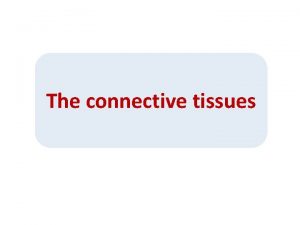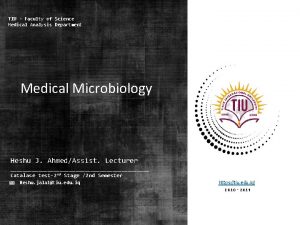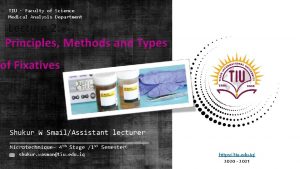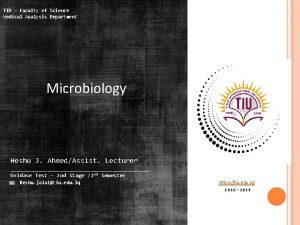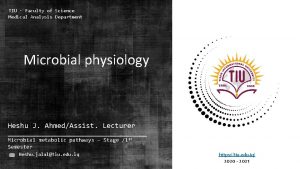TIU Faculty of Science Medical Analysis Department Connective
















- Slides: 16

TIU - Faculty of Science Medical Analysis Department Connective Tissue Azhin S. Ali/Assistant Lecturer _______________________ Histology and Histopathology (lecture 4) – Second Stage /Fall Semester Azhin. saber@tiu. edu. iq /11/2020 https: //tiu. edu. iq/ 2020 - 2021

Connective Tissue Connective tissue provides a matrix that supports and physically connects other tissues and cells together to form the organs of the body. The interstitial fluid of connective tissue gives metabolic support to cells as the medium for diffusion of nutrients and waste products.

Connective Tissue Function: - Binds structures together - Provides support & protection - Fills spaces - Produces blood cells - Stores fat

Components of Connective Tissue 1. Cells A. B. Resident cells Wandering cells a) b) c) d) e) f) Fibroblast Myofibroblast Macrophage Adipose cells Pigment Cells Lymphocyte Plasma cells nuetrophil Basophil Eosinophil Monocytes a) 2. Matrix a) Collagen fiber b) Reticular fiber c) Elastic fiber Fibers b) Ground substances c) Tissue fluid a) b) c) GAGs Proteoglycans Glycoproteins

Components of Connective Tissue

Histopathological significance Edema is the excessive accumulation of interstitial fluid in connective tissue. This water comes from the blood, passing through the capillary walls that become more permeable during inflammation and normally produces at least slight swelling.

FIBERS OF CONNECTIVE TISSUE Collagenous Fibers (bundles) Reticular Fibers (networks) Elastic Fibers (anastomosing bundles)

Histopathological significance Scars; A keloid is a local swelling caused by abnormally large amounts of collagen that form in scars of the skin. Keloids are a type of raised scar. They occur where the skin has healed after an injury. They can grow to be much larger than the original injury that caused the scar. They are not at all common, but are more likely for people who have dark skin. Anything that can cause a scar can cause a keloid

Fibroblasts • Fibroblasts These are the most numerous cells of connective tissue. Description • Typically only the oval nuclei are visible. In tissue sections these cells appear to be spindle shaped, and the nucleus appears to be flattened. When seen from the surface the cells show branching processes. The nucleus is large and has prominent nucleoli. Location • These cells are found associated with the fibers. In the tendon, fibroblasts are seen as elongate nuclei found sandwiched between collagen fibers. Function • They are called fibroblasts because they are concerned with the production of collagen fibers. They also produce reticular and elastic fibers. Where associated with reticular fibers they are usually called reticular cells. • synthesizes the extracellular matrix produces the structural framework (stroma) for animal tissues • Have critical role in wound healing.

Myofibroblasts • Under EM some cells resembling fibroblasts • contain actin and myosin arranged as in smooth muscle, and are contractile. • They have been designated as myofibroblasts. ØLocation • They are found along the periphery of blood vessels and hence, also called as adventitial cells. ØFunction • In tissue repair such cells probably help in retraction and shrinkage of scar tissue. These cells are pleuripotent and develop into new cells when stimulated.

Pigment Cells Description • Typically, such cells are star shaped (stellate) with long branching processes. In contrast to melanocytes such cells are called chromatophores or melanophores. They are probably modified fibroblasts. • Location Ø They are most abundant in connective tissue of the skin, and in the choroid and iris of the eyeball. Along with pigment containing epithelial cells they give the skin, the iris, and the choroid their dark color. Variations in the number of pigment cells, and in the amount of pigment in them accounts for differences in skin color of different races, and in different individuals. Function Of the many cells that contain pigment in their cytoplasm only a few are actually capable of synthesizing melanin. Such cells, called melanocytes, are of neural crest origin. The remaining cells are those that have engulfed pigment released by other cells. • Pigment cells prevent light from reaching other cells. The importance of this function in relation to the eyeball is obvious. Pigment cells in the skin protect deeper tissues from the effects of light (specially ultraviolet light). The darker skin of races living in tropical climates is an obvious adaptation for this purpose. Have critical role in wound healing.

Fat cells (Adipocytes, or Lipocytes) • Aggregations of fat cells constitute adipose tissue. Each fat cell contains a large droplet of fat that almost fills it. As a result the cell becomes rounded (when several fat cells are closely packed they become polygonal because of mutual pressure). The cytoplasm of the cell forms a thin layer just deep to the plasma membrane. The nucleus is pushed against the plasma membrane and is flattened resembling a signet ring. Adipocytes are incapable of division. Functions 1. It acts as a store house of nutrition, 2. In many situations fat performs a mechanical function. The fat around the kidneys keeps them in position. 3. some workers feel that adipose tissue contributes to warmth, not so much by acting as an insulator, but by serving as a heat generator. The heat generated can be rapidly passed on to neighbouring tissues because of the rich blood supply of adipose tissue. Ø Types Adipose tissue is of following two types: i. Yellow (white) or unilocular adipose tissue (adult type) ii. Brown or multilocular adipose tissue (embryonic type). The yellow adipose tissue is the adult type which has been described in detail above.

Macrophage Cells Macrophage cells play an important role in immunological mechanisms. Description Nucleus is often kidney shaped. With the EM the cytoplasm is seen to contain numerous lysosomes. Location During immune response Function They have the ability to phagocytose (eat up) unwanted material (bacteria invading the tissue, and damaged tissues).

Mast Cells Description • These are small round or oval cells. The nucleus is small and centrally placed. The distinguishing feature of these cells is the presence of numerous granules in the cytoplasm. The granules can be demonstrated with the PAS stain. With the EM the “granules” are seen to be vesicles, each of which is surrounded by a membrane (in other words they are membrane bound vesicles). Location They are most frequently seen around blood vessels and nerves. Function 1. The granules contain various substances. The most important of these is histamine. Release of histamine is associated with the production of allergic reactions. 2. Apart from histamine mast cells may contain various enzymes, and factors that attract eosinophils or neutrophils.

TYPES OF CONNECTIVE TISSUE Loose Connective Tissue (e. i. mesentery, omentum) Dense Irregular Connective Tissue (e. i. dermis of skin) Dense Regular Connective Tissue (e. i. tendons, ligaments, cornea)

Thanks for your attention azhin. saber@tiu. edu. iq
 Tiu medical analysis
Tiu medical analysis Quadrant streak
Quadrant streak Contoh tujuan instruksional umum dan khusus
Contoh tujuan instruksional umum dan khusus Anne laure wu tiu yen
Anne laure wu tiu yen Hilangnya sebagian kromosom karena patah
Hilangnya sebagian kromosom karena patah Interpretasi tiu 5
Interpretasi tiu 5 Lecture notes tiu
Lecture notes tiu Lecture notes tiu
Lecture notes tiu Pengertian nilai ambang batas adalah
Pengertian nilai ambang batas adalah C learning tiu
C learning tiu Keralastec
Keralastec Medical faculty in novi sad dean
Medical faculty in novi sad dean Masaryk university medical faculty
Masaryk university medical faculty Masaryk university medical faculty
Masaryk university medical faculty My favorite subject is pe
My favorite subject is pe Bridgeport engineering department
Bridgeport engineering department Bridgeport university computer science
Bridgeport university computer science
